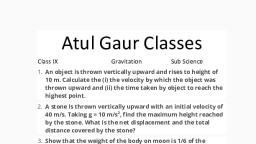Question 1 :
The escape velocity of a sphere of mass $m$ is given by<br>
Question 2 :
When the velocity of a satellite increases, its kinetic energy increases. The satellite nowt revolves in an orbit of
Question 3 :
If suddenly the gravitational force of attraction between the earth and a satellite revolving around it becomes zero, what will happen?
Question 4 :
<u></u>A satellite is revolving near the earth's surface. Its orbital velocity is<br>
Question 6 :
State whether the given statement is True or False :<br/>It is possible to put an artificial satellite into orbit in such a way that it will always remain directly over New Delhi.
Question 7 :
As a body moves from the equator to the poles, the value of g experienced by the body
Question 8 :
Motion of artificial satellite around the earth is powered by :
Question 9 :
If the radius of earth were to shrink by one percent, its mass remaining the same, the acceleration due to gravity on the earth's surface would<br>
Question 11 :
To have an earth synchronous satellites it should be launched at the proper height moving from
Question 12 :
If the mass of earth were $4$ times the present mass, the mass of the moon were half the present mass and the moon were revolving round the earth at the same present distance, the time period of revolution of the moon would be approximately.<br>
Question 13 :
There are two planets. The ratio of radius of the two planets is $K_r$ but ratio of acceleration due to gravity of both planets is $K_g$. What will be the ratio of their escape velocity?
Question 14 :
A body of mass $5\ kg$ is taken into space. Its mass:<br/>
Question 15 :
Two satellites of masses 400 kg, 500 kg are revolving around earth in different circular orbits of radii $r_{1}$, $r_{2}$ such that their kinetic energies are equal. The ratio of $r_{1}$, $r_{2}$ is<br>
Question 16 :
If the gravitational force of earth suddenly disappears, then which of the following is correct?<br>
Question 17 :
The ratio of escape velocities of two planets if $g$ values on the two planets are $9.9$ m/s$^{2}$ and $3.3$ m/s$^{2}$ and their radii are $6400km$ and $3400km$ respectively is<br/>
Question 18 :
An artificial satellite moving in a circular orbit around the earth has a total $(kinetic + potential)$ energy $E_{0}$, its potential energy is:
Question 19 :
The period of a satellite in a circular orbit around a planet is independent of :
Question 20 :
Which of the following is the cause of weightlessness experienced while orbiting around earth on a spaceship ?
Question 22 :
A person sitting in a satellite orbiting earth feels weightlessness due to
Question 23 :
A satellite is in a circular orbit around the earth at an altitude $R$ above the earth's surface, where $R$ is the radius of the earth. If $g$ is the acceleration due to gravity on the surface of the earth, the speed of the satellite is:
Question 24 :
A pendulum beats seconds on the earth. Its time period on a stationary satellite of the earth will be
Question 25 :
Two satellites of masses $50 kg$ and $100 kg$ revolve around the earth in circular orbit of radii $9R$ and $16 R$ respectively, where R is the radius of the earth. The speeds of the two satellites will be in the ratio<br/>
Question 26 :
The escape velocity on the surface of a planet is $V_{e}$ what would be the escape velocity on the planet having the same radius but mass 4 times that of it.
Question 27 :
Time period of a satellite in an orbit of radius R is T. Its period of revolution in an orbit of radius 4R will be<br>
Question 29 :
If both the mass and radius of the earth decrease by $1$% the value of<br>
Question 30 :
A pendulum clock which keeps correct time at the surface of the earth is taken into a mine, then<br>
Question 31 :
Assume that a satellite is revolving around Earth in a circular orbit almost close to the surface of Earth. The time period of revolution of satellite is $( $Radius of earth is 6400 km, $g =$ 9.8 $ms^{-2})$<br>
Question 32 :
While orbiting around the earth in a apaceship, an astronaut experiences
Question 34 :
The time period of a simple pendulum at the center of the earth is:<br/>
Question 36 :
For a satellite escape velocity is 11 km/s. If the satellite is launched at an angle of $60^{0}$ with the vertical, then escape velocity would be <br>
Question 37 :
How much faster than its normal rate should the earth rotate about its axis so that the weight of the body at the equator becomes zero ? (Radius of the earth$= 6.4\times 10^{6}m$ and $ g = 9.8m/s^{2}$)<br>
Question 38 :
The kinetic energy needed to project a body of mass $m$ from earth's surface $($ radius $R$ $)$ to infinity is<br>
Question 39 :
The diameters of two planets are in ratio $4:1$. Their mean densities have ratio $1:2$. The ratio of '$g$' on the planets will be:
Question 40 :
A man weighs $75 kg$ on the surface of the earth. His weight in a geostationary satellite is:<br/>
Question 41 :
The difference in $PE$ of an object of mass $10kg$ when it is taken from a height of $6400km$ to $12800km$ from the surface of the earth is<br/>
Question 42 :
A particle falls towards earth from infinity. The velocity with which it reaches earths surface is<br/>
Question 43 :
Two identical spherical masses are kept at some distance. Potential energy when a mass $m$ is taken from the surface of one sphere to the other
Question 44 :
The time period of an earth satellite in circular orbit is independent of:
Question 45 :
The time period of satellite of earth is $5$ hr. If the separation between earth and the satellite is increased to $4$ times the previous value, the new time period will become:<br/>
Question 48 :
An artificial satellite is revolving in a circular orbit at height of $1200 km$ above the surface of the earth. If the radius of the earth is $6400km$ and mass is $6\times 10^{24}$ kg the orbital velocity $\left ( G= 6.67\times 10^{-11} Nm^{2}/kg^{2} \right)$ is<br/>
Question 49 :
Let $g_h$ and $g_d$ be the acceleration due to gravity at height h above the earth's surface and at depth d below the earth's surface respectively. If $g_h=g_d$, then the relation between h and d is
Question 50 :
While orbiting around the earth in a spaceship, an astronaut weight becomes
Question 51 :
The mass of the moon is 1% of mass of the earth.The ratio of gravitational pull of earth on moon to that of moon on earth will be:
Question 52 :
A satellite of earth of mass '$m$' taken from orbital radius $2R$ to $3R$, then minimum work done is :-
Question 54 :
An artificial sateline moving in a circular orbit around the earth has total energy E (kinetic energy+ potential energy ) . Its potential energy is given by
Question 55 :
The gravitational force between two objects is proportional to $1/R$(and not as $1/R^2$) where R is separation between them, then a particle in circular orbit under such a force would have its orbital speed v proportional to.
Question 56 :
If $g$ is the acceleration due to gravity on the earth's surface, the gain of the potential energy of an object of mass $m$ raised from the surface of the earth to a height equal to the radius $R$ of the earth will be :
Question 57 :
Two satellites $M$ and $N$ go around the earth in circular orbits at heights of $R_M$ and $R_N$ respectively from the surface of the earth. Assuming the earth to be a uniform sphere of radius $R_E$, the ratio of the velocities of the satellites $\dfrac{V_M}{V_N}$ is<br>
Question 58 :
If three uniform spheres, each having mass M and radius R, are kept in such a way that each touches the other two, the magnitude of the gravitational force on any sphere due to the other two is?
Question 59 :
If the acceleration due to gravity on the surface of the earth is $9.8\,\,m/s^2$,  what will be the acceleration due to gravity on the surface of a planet whose mass and radius both are two times the corresponding quantities for the earth ? 
Question 60 :
If $R$ is the radius of the earth and $g$<i> </i>the acceleration due to gravity on the earth's surface, then mean density of the earth is:
Question 61 :
A body of mass $m$ is approaching towards the centre of a hypothetical hollow planet of mass $M$ and radius $R$. The speed of the body when it passes the centre of the planet through a diametrical tunnel is:
Question 62 :
A particle when thrown. moves such that it passes from same height at $2$ and $10 s$, the height is:
Question 63 :
Suppose(God forbid) due to some reason, the earth expands to make its volume eight-fold. What you expect your weight to be?
Question 64 :
Earth is flattened at the poles and bulges at the equator. This is due to the fact that
Question 65 :
The weight of an object at the centre of the earth of radius R is<br>
Question 66 :
A body of mass $m$ is situated at distance $4R_e$ above the earth's surface, where $R_e$ is the radius of earth how much minimum energy be given to the body so that it may escape
Question 67 :
Weightlessness experienced while orbiting the earth in a spaceship is the result of
Question 68 :
If $V_{e}$ is the escape velocity of a body from a planet of mass M and radius R. Then the velocity of the satellite revolving at height h from the surface of the planet will be:<br/>
Question 69 :
The weight of a body at the centre of the earth is
Question 70 :
A very long (length $L$) cylindrical galaxy is made of uniformly distributed mass and has radius $R(R < < L)$. A star outside the galaxy in a plane perpendicular to the galaxy and passing through its centre. If the time period of star is $T$ and its distance from the galaxy s axis is $r$, then:
Question 71 :
A satellite in low earth orbit experiences a small drag force from the earth's atmosphere. The consequence of this drag force will be
Question 72 :
The condition for a uniform spherical mass $m$ of radius $r$ to be a black hole is [$G= $gravitational constant, $g=$ acceleration due to gravity].
Question 74 :
The time period of a second's pendulum inside a satellite will be
Question 75 :
Assume the earth’s orbit around the sun as circular and the distance between their centres as ‘D. Mass of the earth is ‘M’ and its radius is ‘R’. If earth has an angular velocity ‘$\omega _{o}$’ with respect to its centre and ‘$\omega$’ with respect to the centre of the sun, the total kinetic energy of the<br/>earth is :<br/>
Question 76 :
A body is suspended from a spring balance kept in a satellite The reading of the balance is $\displaystyle W_{1}$ when the satellite goes in an orbit of radius $R$ and is $\displaystyle W_{2}$ when it goes in an orbit of radius $2R$ Then
Question 77 :
Escape velocity when a body of mass $m$ is thrown vertically from the surface of the earth is $v$, what will be the escape velocity of another body of mass $4 m$ if thrown vertically
Question 78 :
The ratio of acceleration due to gravity at a depth $h$ below the surface of earth and at a height $h$ above the surface for $h<<R$<br/>
Question 79 :
An artificial satellite is revolving round the earth in a circular orbit. Its velocity is half of the escape velocity. Its height from the earth's surface is:<br/>
Question 80 :
<p>A body falls for $5s$ from rest. If the acceleration due to the gravity of earth ceases to act, The distance travels in the next $3s$ is.</p>
Question 82 :
If mass M is split into two parts, m and $(M-m)$ which are then separated by a certain distance. What ratio of m/M maximizes the gravitational force between the two parts.
Question 83 :
A tunnel is dug along a diameter of earth. The force on a particle of mass $m$ and distance $x$ from the centre in this tunnel will be :
Question 84 :
Find the angular velocity of the earth at which it should rotate so that weight of a body becomes zero at the equator.
Question 85 :
If the gravitational force between two objects were proportional to $\dfrac{1}{R}$ (and not as $\dfrac{1}{R^2}$) where $R$ is separation between them, then a particle in circular orbit under such a force would have its orbital speed $v$ proportional to
Question 86 :
Gravitation on moon is $\dfrac{1}{6} th$ of that on earth. When a balloon filled with hydrogen is released on moon then this.
Question 87 :
A man weighs $60 kg$ at earth's surface. At what height above the earth's surface his weight becomes $30 kg$? (radius of earth  $=6400 km$).
Question 88 :
The time period of an earth satellite in circular orbits is independent of
Question 89 :
The acceleration of a body due to the attraction of the earth (radius $R$) at a distance $2R$ from the surface of the earth is ($g= $ acceleration due to gravity at the surface of the earth)
Question 90 :
The radius in kilometers, to which the present radius of the earth ($R$ $ = 6400$ km) is to be compressed so that the escape velocity is increased ten times is :<br>
Question 91 :
Which of the followings are correct uses of satellite placed in an orbit around Earth?
Question 93 :
If $'R'$ is the radius of the earth, then the height at which the weight of a body becomes $\dfrac{1}{4}^{th}$ of its weight on the surface of the earth is:
Question 95 :
The ratio of acceleration due to gravity at a height h above the surface of the earth and at a depth h below the surface of the earth h < radius of earth
Question 96 :
A particle falling under gravity describes $80 ft$ in a certain sec. How long does it take to describe next $112 ft$?$[g=32fts^{-2}]$
Question 97 :
If $R$ is radius of the earth and $W$ is work done in lifting a body from the ground to an altitude $R$, the work which should be done in lifting it further to twice that altitude is:<br/>
Question 98 :
Ratio of the radius of the earth to that of the moon is $10$. Ratio of $g$ on the earth to the moon is $6$. Then ratio of the escape velocity from the earth's surface to that from the moon is approximately
Question 99 :
A person sitting in a chair in a satellite feels weightless because
Question 100 :
The orbital velocity of a satellite revolving near a planet is.
Question 101 :
The escape velocity of a body from earths surface is $V_{e}$. The escape velocity of the same body from a height equal to $7R$ from the earths surface will be<br/>
Question 102 :
The escape velocity for a body projected vertically upwards from the surface of the earth is ${ 11.2 }{ km } { s }^{ -1 }$. If the body is projected in a direction making am angle ${ 45 }^0$ with the vertical, the escape velocity will be
Question 103 :
Assertion: Kepler's second law can be understood by conservation of angular momentum principle.
Reason: Kepler's second law is related with areal velocity which can further be proved to be based on conservation of angular momentum as $(dA/dt)=(r^2\omega)/2$.
Question 104 :
The time period of a satellite of earth is $5 hr$. If the separation between the earth and the satellite is increased by $3 times$ the previous value, the new time period will become<br/>
Question 105 :
A satellite is orbiting around the earth. By what percent age should increase its velocity so as to enable it escape away from earth:
Question 106 :
Assertion: If we double the circular radius of a satellite, then its potential energy, kinetic energy and total mechanical energy will become half
Reason: Orbital speed of a satellite $v\propto\displaystyle\frac{1}{\sqrt{r}}$ where $r$ is its radius of orbit
Question 107 :
Find approximately the third cosmic velocity $v_3$ in km/s i.e. the minimum velocity that has to be imparted to a body relative to the Earth's surface to drive it out of the Solar system. It is given that the rotation of the Earth about its own axis is to be neglected.
Question 108 :
The distance between two planets of masses M and 4M is 'a' what is the gravitational potential at a point on a line joining them of which the gravitational intensity is zero?
Question 109 :
A body of mass $m$ is taken from earth's surface to the height equal to the radius of earth, the change in potential energy will be of
Question 110 :
If the gravitational acceleration at surface of earth is $ g$, then increase in potential energy in lifting an object of mass $m$ to a height equal to the radius $R$ of earth will be.
Question 111 :
Four particles of masses $m, 2m, 3m$ and $4m$ are placed at the corners of a square of side length $a$. The gravitational force on a particle on a particle of mass $m$ placed at the centre of the square is
Question 112 :
Planet $Y$ has density $D$, and surface gravitational acceleration, $g$. The radius of planet $Y$ is suddenly doubled while its density remains the same. Compared to the original $g$, the new value of the surface gravitational acceleration would be which of the following?<br>
Question 113 :
A particle would take time $t_1$ to move down a straight tube from the surface of earth (supposed to be homogeneous sphere) to its centre. If gravitational acceleration were to remain constant, time would be $t_2$. The ratio $t/t'$ will be
Question 114 :
A planet has a miss of eight times the mass of earth and density is also equal to eight times the average density of the earth. If g be the acceleration due to earth's gravity on its surface, then acceleration due to gravity on planet's surface will be :
Question 115 :
Two balls are dropped from the same height from places $A$ and $B$. The body at $B$ takes two seconds less to reach the ground at $B$ strikes the ground with a velocity greater than at $A$ by $10 m/s$. The product of the acceleration due to gravity at the two places $A$ and $B$ is:
Question 116 :
The jupiter's period of revolution around the sun is 12 times that of the earth. If radius of earth orbit is 1 AU, find radius of Jupiter's orbit<br/>
Question 117 :
By what percent the energy of the satellite has to be increased to shift it from an orbit of radius $r$ to $\dfrac {3r}{2}$
Question 118 :
The Jupiter's period of revolution around the Sun is $12$ times that of the Earth. Assuming the planetary orbits to be circular, find the acceleration of Jupiter in the heliocentric reference frame.
Question 119 :
A planet has mass 1/10 of that of earth, while radius is 1/3 that of earth. If a person can throw a stone on earth surface to a height of 90 m, then he will be able to trow the stone on that planet to a height-
Question 120 :
Two satellites A and B of masses $m_1$ and $m_2 (m_1=2m_2)$ are moving in circular orbits of radii $r_1$ and $r_2 (r_1=4r_2)$, respectively, around the earth. If their periods are $T_A$ and $T_B$, then the ratio $T_A/T_B$ is
Question 121 :
A body weighs $160\ N$ on the earth. Find its weight on another planet whose mass is $\dfrac {5}{2}$ times mass of earth and radius $\dfrac {4}{5}$ times that of earth.
Question 122 :
Imagine a new planet having the same density as that of the earth but it is $3$ times bigger than the earth is size. If the acceleration due to gravity on the surface of the earth is g and that on the new planet is g', then what is the value of g'/g?
Question 123 :
If the mass of a planet is $10\%$ less than that of the earth and the radius is $20\%$ greater than that of the earth, the acceleration due to gravity on the planet will be.
Question 124 :
A body of mass $m$ is moving in a circular orbit of radius $R$ about a planet of mass $M$. At some instant, it splits into two equal masses. The first mass moves in a circular orbit of radius $\dfrac{R}{2}$, and the other mass, in a circular orbit of radius $\dfrac{3R}{2}$. The difference between the final and initial total energies is:
Question 125 :
Two identical satellites are at the heights $R$ and $7R$ from the earth's surface. Then which of the following statement is incorrect: ($r =$ radius of the earth).
Question 126 :
The maximum and minimum distance of earth from sun are $r _ { 1 }$ and $r _ { 2 }$ respectively What will be the distance of earth from sun when its position vector is perpendicular to the major axis of its orbit
Question 127 :
Which of the following statements are true about acceleration due to gravity?<br>
Question 128 :
Let $V$ and $E$ denote the gravitational potential and gravitational field at a point, respectively. It is possible to have<br>
Question 129 :
At what height the acceleration due to gravity will be reduced to $36\%$ of its value on the surface of the earth?
Question 130 :
A satellite moving on a circular path of radius $r$ around Earth has a time period $T$. If its radius slightly increases by $\Delta r$, the change in its time period is<br>
Question 132 :
Two bodies of masses $2kg $ & $1.8 kg $ are separated by $20 m $ .<br>The distance of neutral point from smaller mass is :
Question 133 :
A stone weight 100 N on the surface of the earth. The ratio of its weight at a height of half the radius of the earth to its weight at a depth of half the radius of the earth will be approximately
Question 134 :
A satellite of mass $m$ revolves around the earth of radius $R$ at a height $x$ from its surface. If $g$ is the<br/>acceleration due to gravity on the surface of the earth, the orbital speed of the satellite is: 
Question 135 :
A body of weight $1N$ is placed at the surface of the earth, which is assumed to be a perfect sphere of radius $6400 km $ . It is taken to a height of $600 km $ , the weight of the body, in $N$ , would be :
Question 136 :
A projectile is fired from the surface of earth of radius $R$ with a velocity $kv _{e}$ (where $v_{e} $ is the escape velocity from surface of earth and $k < 1)$ Neglecting air resistance, the maximum height of rise from the centre of earth is 
Question 137 :
A person brings amass of $1 kg$ from infinity to a point A lnitially, the mass was at rest but it moves at a speed of $3 m/s$ as it reaches A. The work done by the person on the mass is $- 5.5 J$ The gravitational potential at $A$ is
Question 138 :
The ratio of the radii of the planets $P_{1}$ and $P_{2}$ is $k_{1}.$ The corresponding ratio of the acceleration due to the gravity on them is $k_{2}.$ The ratio of the escape velocities from them will be<br>
Question 139 :
Read the assertion and reason carefully to mark the correct option out of the options given below :<br/>Assertion : At height $h$ from ground and at depth $h$ below ground, where h is approximately equal to $0.62 R$, the value of $g$ acceleration due to gravity is same.<br/><br/>Reason : Value of $g$ decreases both sides, in going up and down.
Question 140 :
A planet of mass $m$ is moving in an elliptical orbit about the Sun (mass of Sun = $M$). The maximum and minimum distances of the planet from the Sun are $r_1$ and $r_2$ respectively. The period of revolution of the planet will be proportional to:
Question 141 :
The escape velocity on a planet is equal to the orbital velocity on another planet . If the radii of two planets are equal, determine the ratio of acceleration due to gravity on the two planets
Question 142 :
Two satellites of masses ${ m }_{ 1 }$ and ${ m }_{ 2 }$ $\left( { m }_{ 1 }>{ m }_{ 2 } \right) $ are revolving around the earth in a circular orbit of radii ${ r }_{ 1 }$ and ${ r }_{ 2 }$ $\left( { r }_{ 1 }>{ r }_{ 2 } \right) $, respectively. Which of the following statements is true regarding their speeds ${ \nu }_{ 1 }$ and ${ \nu }_{ 2 }$
Question 143 :
A man weighs 200 pounds on earth. How much would he weigh on a planet four times as massive as the earth with a radius five times as great?
Question 144 :
Students I, II and III perform an experiment for measuring the acceleration due to gravity (g) using a simple pendulum. They use different lengths of the pendulum and/or record time for different number of oscillations. The observations are shown in the following table. Least count for length = $0.1 cm$, Least count for time = $0.1s$.<br/><table class="wysiwyg-table"><tbody><tr><td>Student</td><td>Length of Pendulum (cm)</td><td>Number of Oscillations(n)</td><td>Total Time for n Oscillations (s)</td><td>Time Period (s)</td></tr><tr><td>I</td><td> 64.0</td><td>8</td><td>128.0</td><td>16.0</td></tr><tr><td>II</td><td>64.0</td><td>4</td><td>64.0</td><td>16.0</td></tr><tr><td>III</td><td>20.0</td><td>4</td><td>36.0</td><td>9.0</td></tr></tbody></table>If $E_I, E_{II}, E_{III}$ are the percentage errors in g, i.e., $(\frac{\triangle g}{g}\times 100)$ for students I, II and III, respectively, then<br/>
Question 146 :
Assertion: The smaller the orbit of a planet around the Sun, the shorter is the time it takes to complete.
Reason: According to Kepler's third law of planetary motion, square of time period is proportional to cube of mean distance from Sun.
Question 147 :
A $60kg$ man is inside a lift which is moving up with an acceleration of $2.45\ {ms}^{-2}$. The apparent percentage change in his weight is:
Question 148 :
At what distance above the surface of earth, the gravitational force will be reduced by $10\%$, if the radius of earth is $6370$ Km.<br/>
Question 149 :
A sky laboratory of mass $2\times 10^{3}Kg$ is raised from a circular orbit of radius 2R to a circular orbit of radius 3R. The work done is (approximately):<br>
Question 150 :
Journey in a train is adventurous particularly when you have a seat. The girl sitting near window ate a banana and dropped the peel from the window. Her co-passenger looking through the window found that it dropped vertically down and touched the ground in $0.2s$. After sometime she requested her sister sitting on the upper berth to drop a chocolate bar.The sister dropped the bar, but it fell in front of the girl instead of reaching her hand. She was angry but the co-passenger calmed her by saying that she dropped exactly in line of your hand but as the train is accelerating it did not reach you and fell in front of you. If a projectile has velocity greater than escape velocity which trajectory it will follow<br/>
























